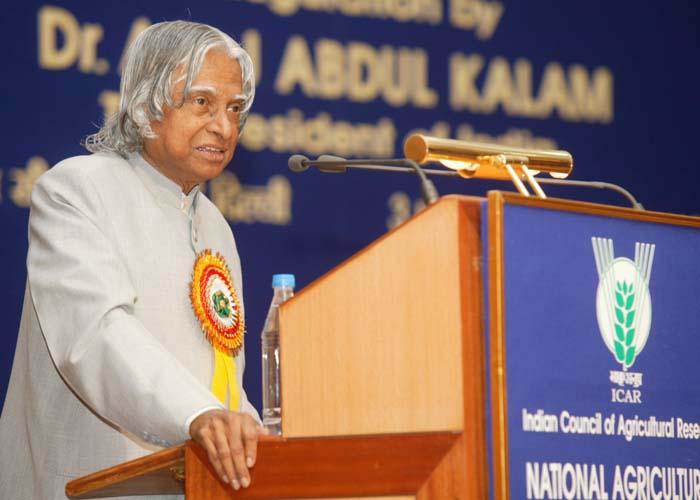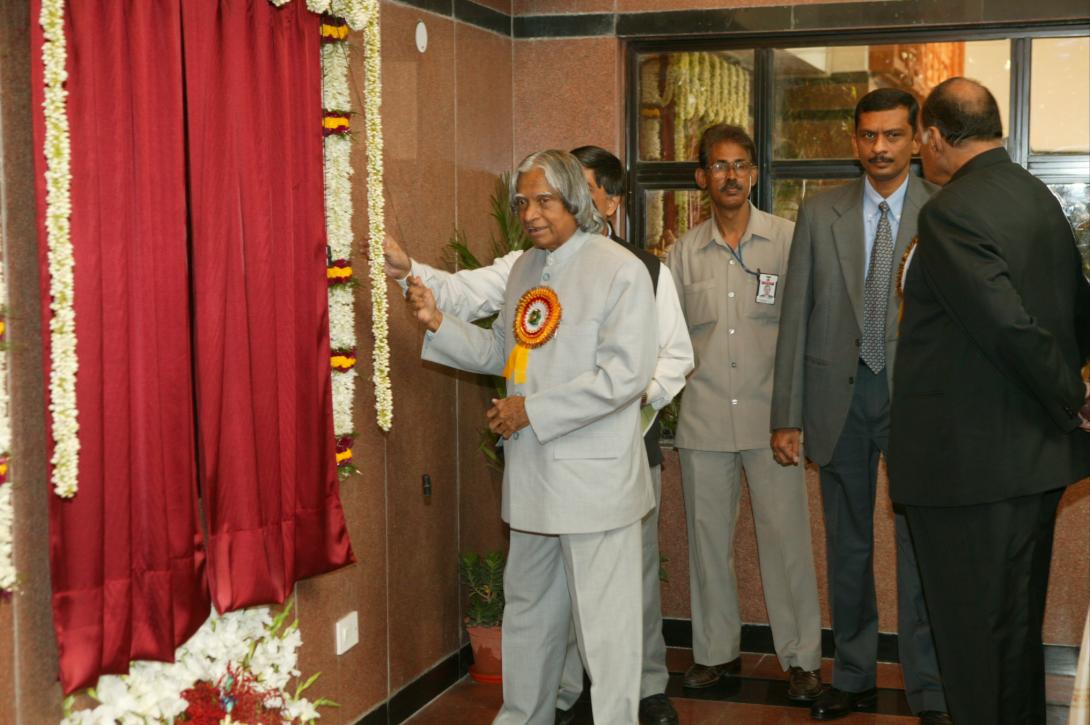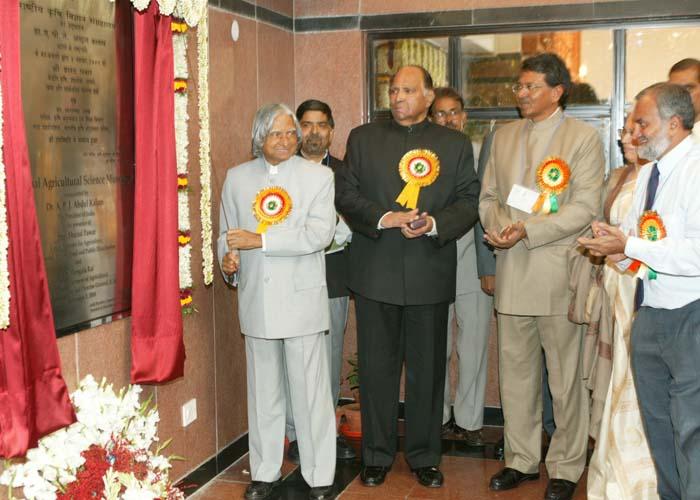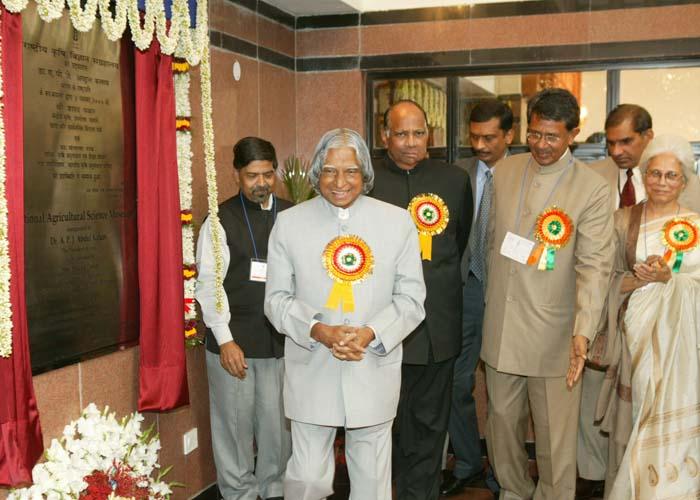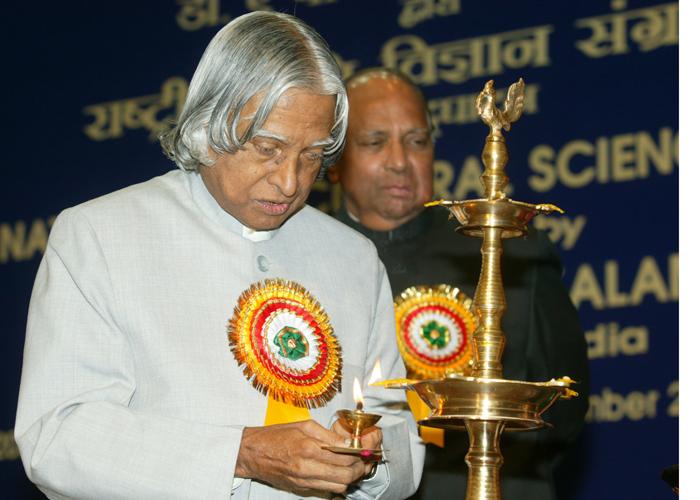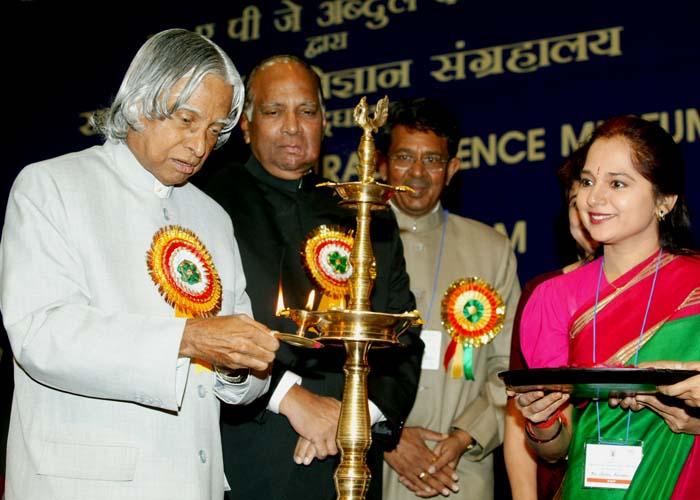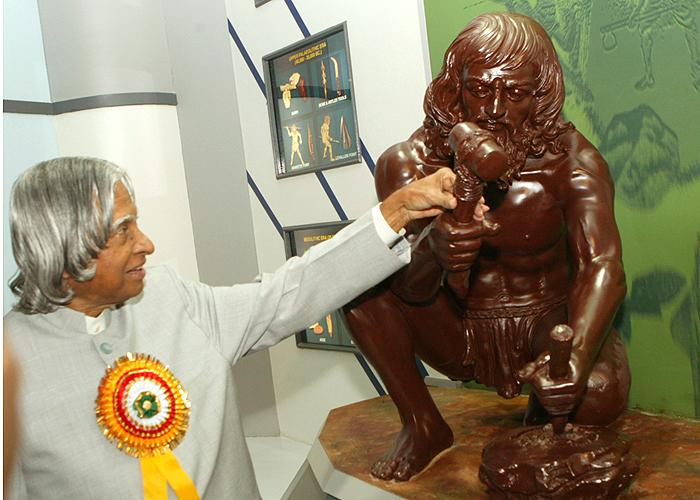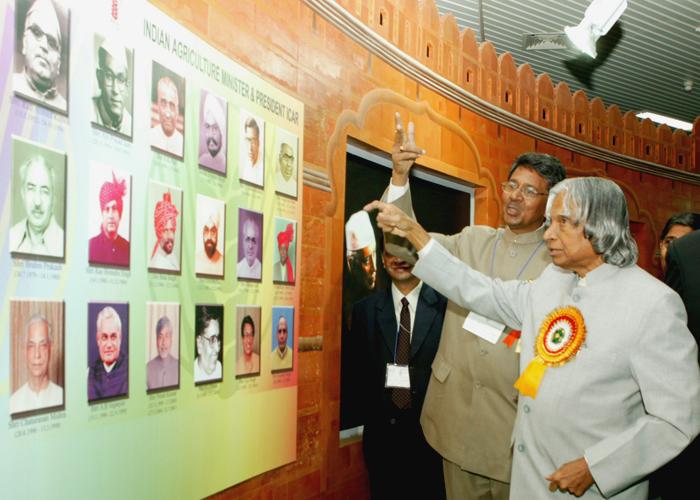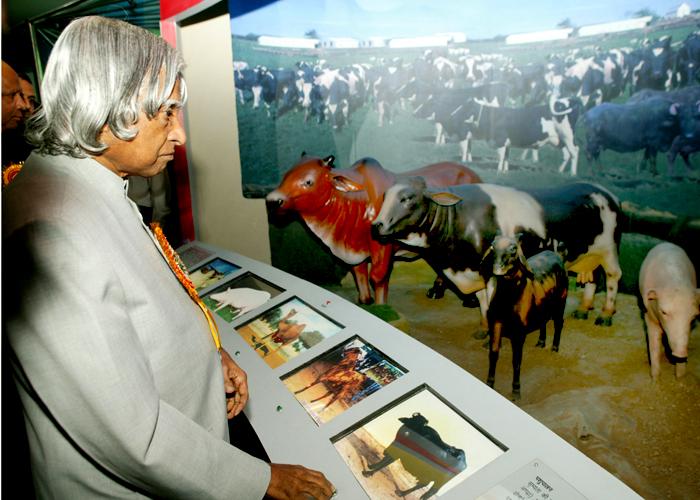Address During The Inauguration Of National Agriculture Science Museum
NASC Complex, PUSA, New Delhi : 03-11-2004
Museum as a Knowledge Propagator
I am delighted to participate in the inauguration of the National Agriculture Science Museum created by Indian Council of Agricultural Research (ICAR). I extend my greetings to the organizers, agricultural scientists & technologists, agricultural planners, farmers, students and distinguished invitees. Just now I visited the Museum and I noticed that the six pillars of agriculture are soil, water, climate, seed, tools, and peasants. In my perception, Science and Technology, the inter-relationship among the agricultural artifacts and the marketing of the agro products to the society are the three additional components required for sustainable success in agricultural missions. I would like to share with you few examples to illustrate my perception.
Seed Cotton Productivity
Textile industry is very important for the Indian economy. The basic raw material is cotton. India is the third largest producer of cotton in the world. However, compared to the world average of 700 kgs of seed cotton per acre we produce only 350 kgs of seed cotton per acre. It is indeed a technological concern for the nation. On 4th March 2004, I met the members of the CII National Council, where Shri Oswal of Vardhman group, who had adopted the village Nava Pind in Punjab during the year 2003, brought out one important achievement. This programme was a cooperative movement of the farmers, scientists, trainers and the industry, launched in Nava Pind village having an area under cotton of over 1200 acres. A training programme was launched for farmers starting with soil characterization, matching the cottonseed to soil, water and fertilizer management. They were also trained on proper application of fertilizer and pesticide during the seeding and growth process in the right season and proper irrigation techniques to enhance the productivity of cotton.
This form of exposure that the farmers had is a holistic approach that combines the understanding of the crop dynamics, environment, best farm practices and of course the Agricultural Technology. The project resulted in increasing the average seed cotton yield of the village from 450 KG per acre during the year 2002-2003 to 950 KG per acre for the year 2003-2004, that too at a considerably reduced investment. This led to the increase in net return per acre in the village from Rs. 2400 per acre to Rs. 17,000 per acre (a seven times increase in return). This programme has been extended to ten villages in this year and is being extended to four villages in the coming year. The total wealth generation capability of this programme for the entire nation could be of the order of Rs. 25,000 Cr.
Higher Yield of Agriculture Production and Technology infusion.
Bihar experience: I would like to share with you the enhancement of agricultural productivity in Bihar. Prof SK Sinha, one of your fellow agricultural scientists and the former Director IARI, and TIFAC took up a project on "A System's Approach to Enhance Agricultural Productivity in Central Bihar and Eastern India". ICAR unit at Patna participated. About 6 villages of RP Channel-5 and nine villages of Majhauli distributaries were selected during the Kharif season of 1998. The system approach consisted of soil analysis, seed choice, cultivation season, fertilizer selection and training to the farmers particularly usage of remote sensing data.
TIFAC team with ICAR with the support of District Collector, a roadmap was prepared. The analysis was done on why Bihar farmers in a certain areas should get 2 MT/hectare while their counterparts in Punjab and Haryana get 8 MT/hectare. Intensive training was given to the farmers by renowned scientists who included right type of seed selection to suit the soil, right type of fertilizer and proper water management and also the importance of when to sow the seed. Many cooperative societies were activated for seed, fertilizer supplies and water management. This experiment resulted in to 6 tonnes yield from 2 tonnes. This reveals the potential of the land, quality of the workforce, water and fertilizer management. When the farmers harvested, they saw abundance not only in wheat production but also various type of vegetables. This intensive collaboration of scientists and farmers resulted nearly increase to 5 tons/hectare yield of wheat. Naturally these bring new issues like equipment for faster harvesting, storage, marketing and banking system which has to be addressed.
Ginger: I came across a book called "Ginger"written by an American, who is a friend of India. The author feels that the drug based on Ginger will replace aspirin with no side effects and his mission is to propagate Ginger as a drug. After I finished reading the book I asked him, you are a friend of India, why your company is purchasing Ginger from Indonesia and Brazil for making the drugs. He answered that there are twelve ingredients in Ginger, out of which six are very important from medicinal point of view. Indian ginger when analyzed, we find that four of these ingredients are missing. According to him, the reasons for this are, even though India produces large amount of ginger, farmers have not been trained about the right time in a year to be cultivated, right soil characteristics, right duration of the crop, right nutrient to be added during its growth and the right type of water management and finally the right timing of harvesting. The quality crop the of Ginger crop as a function of all the above parameters should find a place in the museum for enriching the knowledge of the farmers and make our products internationally competitive.
Unlike the western agricultural system, the Indian food chain had health as an important component in herbal medicine like turmeric, neem, dry ginger, pepper, garlic etc., but due to the onslaught of the western medicine facing extreme competition in India, our medicinal plants have resurfaced from the western source with a new package and a label. The museum should be a store house of knowledge of such indigenous plants.
IPR: As we all know, in the last decade India had to fight in international courts for protecting our intellectual property rights arising out of our own heritage plants. These disputes mainly arose in respect of Basmati Rice, Neem and Turmeric. Particularly the audience of agriculture scientists will know that one can take a new patent by modifying certain original performance, for example, addition of fragrance or nutrition or medicinal value to the plant. In all these cases, to protect our rights, we must have adequate historical evidence of our accomplishments and usage in traditional system. Now we have to create a database of traditional system in food and medicinal plants, and the museum must become a proud and dynamic custodian.
Tele-Crop diagnosis: Agriculture would form one of the key inputs for improving the economy in the country. The technologies is right now available for using the electronic connectivity of PURA for improving the agricultural productivity. Using inexpensive wireless cameras, a farmer would transmit the pictures of his crop and cattle to expert located miles away and get his advice on diagnosing the disease affecting the crop or the cattle and also get a tele-prescription for taking remedial measures. These types of technological know-how can be pictorially presented in multiple languages in the museum, which will enable the farmers to make use of it for their advantage.
PURA: PURA's electronic and knowledge connectivity can also be used to Create a Community of Interest (CCI) to share knowledge. Any one of the members of the villages in the clusters of PURA can float a question in his language either by text or by voice (SMS) for the other members of the community to answer. The people who answer these questions will be rewarded by paying them a nominal fee. All the questions and correct answers are accumulated as a knowledge base of the community. It will also have information localized for that community. Over a period of three to four years, the knowledge base will grow to an extent that almost all the answers for the questions that the new farmer would have, become already a part of the database.
Greening of Leh Valley
Another experience, I would like to mention is about that the DRDO laboratory located at Leh which is an altitude of 11500 feet above mean sea level. This area was a cold desert during the 90s. The scientist and technicians of the laboratory have worked hard to convert this cold desert into a green valley by developing appropriate agro-technologies using greenhouses in consultation with the farmers and the district planners. They have also enabled the farmers to market the products to the Defence Forces whose fresh ration was coming from plains through airlift. In the last decade they have been able to develop fourteen types of vegetables such as potatoes, tomatoes, cabbage, cauliflower, peas, chilies, leafy vegetables etc. This has generated wealth for the local farmers and saving of several crore of rupees to the Defence Forces on account of airlift. Recently, the agricultural scientist of DRDO have developed a beverage named 'Leh-Berry' using local flora ? Seabuckthorn which naturally grows abundantly in this area. This year itself fruits worth Rs. 55 lakhs have been harvested and given to the industry which will be converted into a health beverage costing over Rs. 10 Crore. This is the type of value addition this product is able to provide. Several other products are also being developed using the same Seabuckthorn bush. The success in this programme comes out of the partnership between agricultural scientist & technologists, industrialists, district planners, farmers and the troops.
An Experience of Sugarcane Yield and Agro bio-technology:
The typical research potential in sugarcane development is the following. (a) Less water cultivation (b) 12-18 months growth cycle (c) cost of input for sugarcane cultivation and also sugar production (d) regulated growth cycle of sugarcane so that factories can get continuous supply of sugarcane. Recently in India, our scientists have been able to evolve newer sugarcane varieties through micro-propagation so that new transgenic varieties can be grown.
Apart from the genetic engineering, research has been intensified on molecular characterization of the sugarcane genome, molecular diagnosis of diseases and molecular biology of sugarcane pathogens and nitrogen fixing micro-organisms. The molecular characterization of sugarcane genome is useful in early selection of desirable plants in the breeding programme on the basis of molecular markets. It also isolates desirable genes (for resistance to biotic and abiotic stresses) from the wild relative species of sugarcane so as to transfer them in the cultivated varieties. Molecular characterization of the disease causing organisms like viruses is useful in controlling the diseases. Development of higher nitrogen fixing microbes will be useful in sustainable and low cost sugarcane production. Combined effect of all these research areas enables production of high yield sugarcane all through the year. Since India has to compete in the world?s sugar market, all the more it is important to bring down the cost by making value addition to the by-product such as ethanol for bio-fuel which can be used for power generation and automobile sector. The Science museum can display the by-products arising out of each agro processing units.
I have shared with you these experiences, since I found that all of them provided value addition to the farm products. I am sure there will be number of such experiences spread in different parts of the country. The museum authorities should acquire and consolidate all such experiences and present them in an easily understandable form for the farmers to apply in their own area.
Missions for the Agricultural Museum
I would suggest incorporation of the following additional features in this agricultural museum.
1. Incorporation of a mechanism, to update the information displayed in the museum to enable the students, farmers and researchers to get the latest information on agricultural development at one single point.
2. The museum authorities can consider creation of a website in which a virtual museum (Virtual walkthrough) is created for use by farmers and students spread all over the country.
3. The developments taking place in various agricultural universities/institutes, various states and individual innovative farmers can also be collated and displayed in the museum for faster dissemination of data to the farming community.
4. Since the farmers are going to be the beneficiary of this museum, we may consider having a mobile museum which can move to different parts of the country and be of use to the farmers located in different regions.
5. Successful farmers can give a lecture in the museum once in a month apart from scientists, based on their personal experiences, which can be emulated by other farmers in the region. Museum can also publish a news letter in different languages for propagating the success stories, so that the value addition to the farming community becomes the focus.
6. The museum authorities can organize a competition among various agriculturists and farmers to bring out the best practices in farming on different commodities in different climatic regions followed in the country. These nominations can be evaluated by noted jurists and the best models can be recognized and rewarded.
7. National innovation foundation recognizes ideas provided by rural innovators every year. The museum should capture these ideas and present it in the museum in a separate section, which can be used by the other farmers.
8. In the coming decade, the availability of land is going to get halved and the water availability is also going to be reduced. But the productivity has to double. For realizing this type of the growth, certain models for semi-arid land cultivation created by the agencies like ICRISAT should also find a place in the museum.
9. As we keep doing more and more research in bio-technology and come up with new seeds and new species of plants, the older ones will slowly disappear. The museum should preserve such seeds and species because in some future date, the new seeds may have some negative side effects, may not prove to be as tasty as older species. We may have to replace it with the older species.
10. Whenever we visit the museum we should feel proud of our heritage and how we grew from abject poverty to the exporter of food. It should act as an encouragement for us to repeat what has happened in agriculture to repeat in other areas.
Conclusion
Advances in science particularly in Biotechnology, Information Technology and Nano-technology are expected to bring a revolution in agriculture technology. There should be an exclusive session in the museum to present the visualization of the future, particularly the agricultural growth trajectory. One of our core strengths is biodiversity. India is one of the 12 mega-biodiversity centres of the world, with more than 12% of flora, 15% of fauna and 10% of aquatic biota. Biodiversity integrated with technology - for developing a genetically engineered seed or transforming a molecule extracted from an herb into a drug, adds dramatic value that can be a wealth generator for the nation.
I strongly believe that today?s museum has a major role to play and should act as a science and technology window to our country. The museum should have interactive displays to present how India will graduate through the second green revolution to reach the production target of 400 million tonnes of food grains per year by the year 2020. This presentation will lead to inspiration for the researchers, students, farmers, some times even the political and administrative functionaries.
I would like to compliment the Indian Council of Agricultural Research and the National Council of Science Museums, for creating this unique facility. I am sure; it would inspire many a visitor, particularly farmers and students, for furthering the cause of Agriculture for a strong India.
My best wishes for success in all your missions.
May God bless you.

